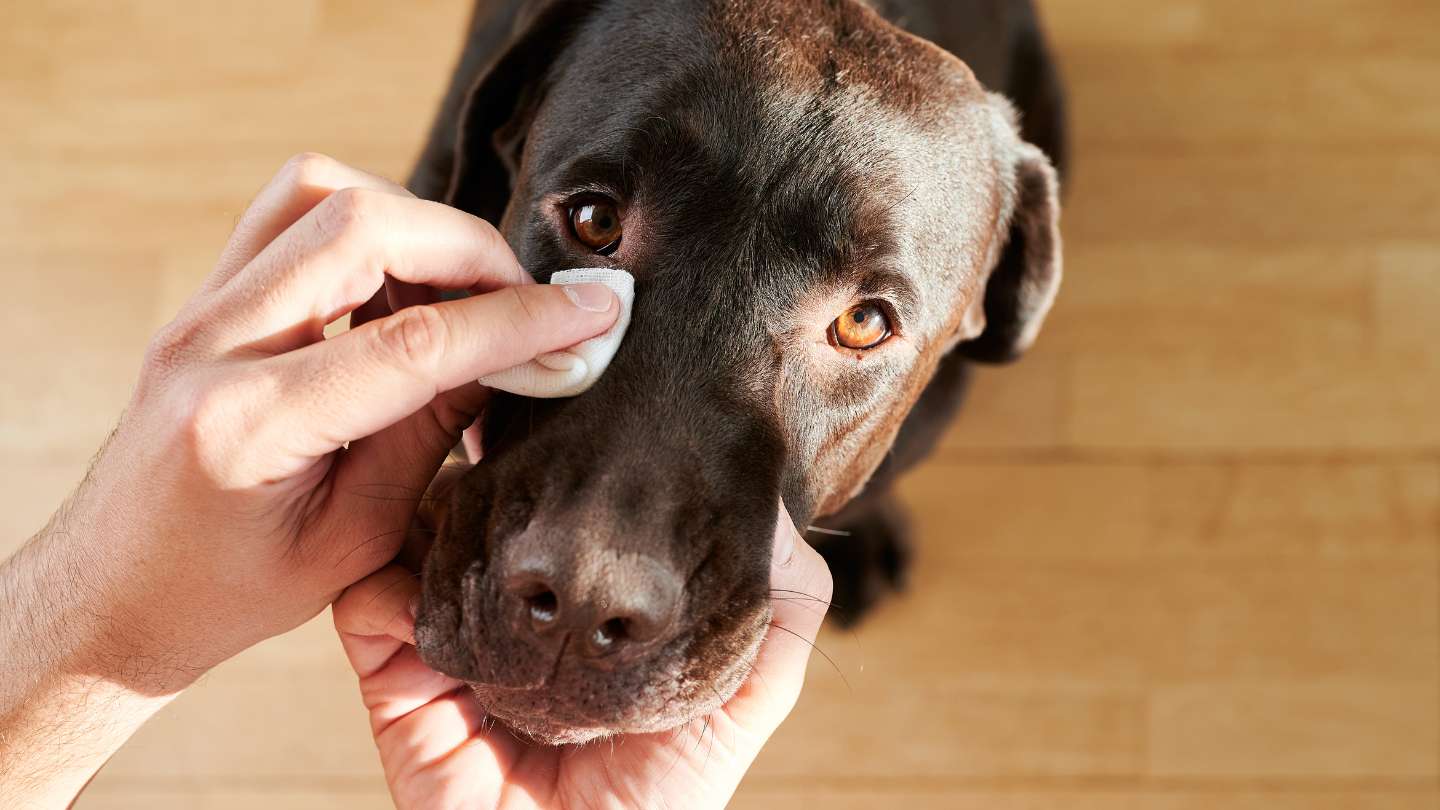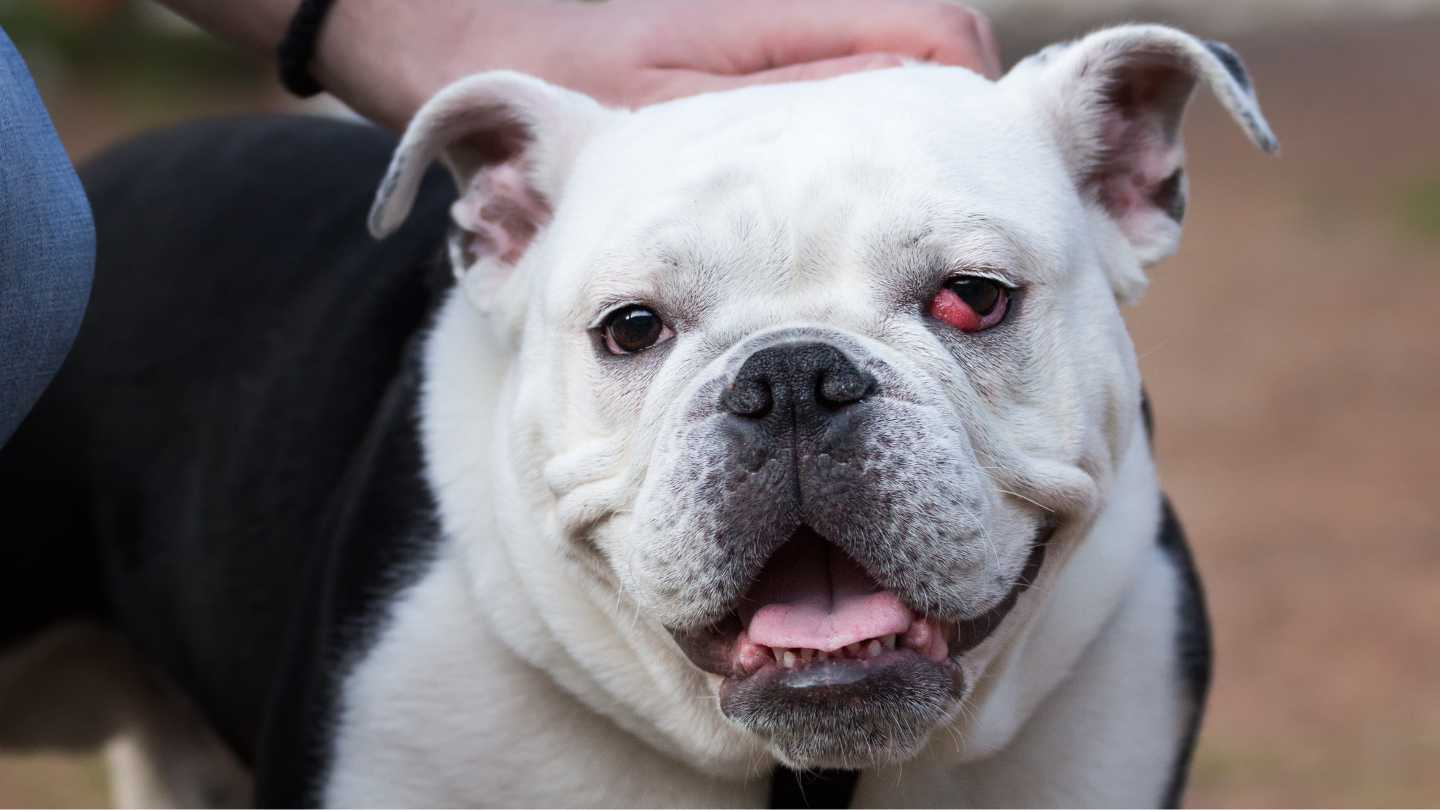Summer has come and passed far too quickly, per usual. As you attempt to catch as much sunshine as you can before the season changes, you may find yourself walking your dog a little longer than usual or grilling food more than you usually do. With the pending change in weather temperatures and air moisture, many people experience a shift in their immune systems. Historically speaking, sickness sees a significant increase in the winter months – which comes as no surprise. The uncertainty of spreading illnesses between each other, let alone our pets, helps us to remember to foster healthy environments by washing hands, taking vitamins, and keeping social distance when feeling under the weather. All of which begs the question, can you get sick from a dog?
Symptoms of a sick dog
The first step in dealing with a sick dog is always recognizing symptoms. Dogs are usually good at expressing discomfort, and believe it or not, there are many instances in which dogs can sense when you’re sick! Yet most of the time, a dog will not vocalize being in pain or feeling sick. Pawrade recommends every person and family be knowledgeable of common puppy illnesses that require immediate attention before causing worse symptoms. If you are planning to become a first-time dog owner, being prepared for the possibility of a sick dog is extremely important in getting ready for a puppy.
Common symptoms of a sick dog include loss of appetite, red eyes, sneezing and coughing, and behavioral changes in general. These are the same familiar signs of humans feeling under the weather. Just like in humans, sickness is often distinguished by general symptoms, which include:
- Lethargy: A sudden decrease in interest in food or water can be a sign of illness in dogs.`
- Diarrhea: Changes in bowel habits, such as diarrhea, can be indicative of digestive issues or infections.
- Nasal or eye discharge: Discharge from the nose or eyes that is colored, thick, or accompanied by other symptoms could indicate infections or allergies.
- Change in appetite: A sudden decrease in interest in food or water can indicate illness in dogs. Quick increases or decreases in weight can also be indicative of illness.
- Change in behavior: Aggression, anxiety, and unfamiliar temperaments might be a response to underlying discomfort or illness.
Remember that these symptoms can vary in severity and some may overlap with other health conditions. If you notice any of these signs in your dog, it's recommended to consult a veterinarian for a proper diagnosis and appropriate treatment. Early detection and intervention can significantly improve your dog's chances of a swift recovery.
Canine influenza (flu in dogs)
Kids are going back to school, adults are going back to work in offices, and all major league sports are almost back in full swing. Along with the mark of the new chapter, flu season is also right around the corner. In preparation for flu season, you may be wondering if dogs can get the flu. While the answer is yes, it is not the same flu that humans are vulnerable to. There are four types of Influenza (flu), classified by the letters A, B, C, and D. Canine Influenza is a strain that falls under Group A, differing from the strains that affect humans. Interestingly enough, canine influenza virus originated from horses and was then spread to dogs. Scientists first identified canine influenza in racing greyhounds back in 2004.
Due to the contagious nature of the flu, Pawrade mandates its breeders to take every action to prevent canine influenza from affecting their puppies. Pawrade’s strict code for compliance enforces breeders to follow an ethical and time-effective administration of the 3 Rounds of Core Vaccines. This being said, many breeders across the board (not just in Pawrade's network) have limited on-site visitations for fear of pet-seekers exposing the puppies to unfamiliar germs and bacteria – especially during and after COVID-19! It is an important thing to remember as you figure out how to find a reputable breeder. So while your puppy from Pawrade will be up-to-date on vaccinations and ready for adventure, it is recommended to talk to a veterinarian about future booster flu shots for your dog. The American Kennel Club recommends an annual flu shot for dogs, similar to humans.
Even though there have been a few cases of dogs getting the flu from humans, there are no reported cases of humans getting the flu from dogs. If your dog does have the flu, consider it safe to snuggle with your dog and keep him or her comfortably close!
Strep throat in dogs (Streptococcus in dogs)
When we think of strep throat, we often associate it with humans, but did you know that our furry dog friends can also suffer from strep? Strep throat in dogs is not as common as in humans, partially because the strains that affect each species are different. In humans, the primary culprits are Streptococcus pyogenes bacteria. Dogs, on the other hand, can be affected by various strains of streptococcal bacteria, including Streptococcus zooepidemicus and Streptococcus canis. Exposure to these bacteria, primarily from infected dogs or contaminated environments, is the main cause of strep throat in dogs. Like in humans, the bacteria enter through the throat and can cause inflammation and discomfort. The most common symptoms of strep throat in dogs include:
- Coughing: Dogs with strep throat may develop a persistent and harsh-sounding cough.
- Difficulty Swallowing: Inflamed throat tissues can make swallowing painful for dogs, leading to drooling or reluctance to eat.
- Lethargy: Dogs with strep throat might become lethargic and lose interest in their usual activities.
- Increased salivation: Due to difficulty swallowing, dogs may drool more than usual.
- Fever: If your dog's temperature is elevated along with the above symptoms, it could indicate strep throat.
If you suspect your dog has strep throat, then consult a veterinarian for a proper diagnosis and treatment plan. The veterinarian will perform a physical examination, possibly followed by a throat swab to identify the specific bacteria causing the infection. Treatment usually involves a combination of antibiotics and supportive care. Antibiotics are prescribed to target and eliminate the bacterial infection. Pain relief medication can help alleviate discomfort, making it easier for your furry friend to eat and drink. Ensuring your dog stays hydrated and providing soft, easy-to-swallow foods can aid in their recovery.
While dogs can transmit strep throat to other dogs, it's important to note that dogs cannot directly pass strep throat to humans. The strains of strep throat that affect dogs are different from those that typically affect humans, reducing the risk of cross-species transmission.
Kennel cough in dogs (Bordetella in dogs)
Bordetella, popularly known as kennel cough, is quite similar to strep throat in dogs but they are not the same. Even though the symptoms overlap, the cause is from different strains of bacteria. Dogs are more likely to come down with kennel cough versus strep throat, especially when they are in places where there are a lot of other dogs. This is the main reason that Pawrade breeders give puppies the Bordetella vaccine, because the puppies sleep, eat, and play in close proximity while growing up. Other places to be cautious of are pet groomers, veterinarian offices, and dog parks. If your puppy dog has the vaccine then your worries will be significantly reduced!
Kennel cough is namely an illness that affects pets, like dogs and cats. It is highly unlikely for dogs to give kennel cough to people. Instead, humans contract bronchitis and pneumonia far more readily than kennel cough.
COVID-19 in dogs
In today’s world, it is not surprising to think that many dog owners are curious if their dog can get COVID, and if so, can someone get COVID from dogs? There have been a limited number of accounts of dogs testing positive for COVID-19, but it has happened. It is rare for COVID-19 to transmit from humans to animals, and even more rare for COVID-19 to transmit from animals to humans. That being said, if you test positive for COVID, take the necessary precautions when caring for your dog.
Symptoms can vary in severity but If you notice any of these signs in your dog, it's recommended to consult a veterinarian for a proper diagnosis and appropriate treatment. Take the necessary steps before, during, and after your dog has been diagnosed with COVID-19:
- Wash your hands before feeding your dog or filling up the water bowl.
- Reduce close contact with your dog, whether it is snuggling or petting.
- Do not put a mask on your dog, ever!
Overall, do not fear for your dog to contract COVID-19. Even though there is no vaccine to protect pets from SARS-CoV-2, make sure your dog is staying hydrated and resting. However, if you or your dog test positive for COVID-19, follow the above recommendations to minimize the chance of passing COVID to your dog (and vice versa)!
Pink eye in dogs (conjunctivitis in dogs)
Conjunctivitis, commonly known as “pink eye,” is a perennial sickness, meaning it is active year-round. Reported cases seem to rise during flu season for all of the same reasons. While pink eye in dogs is not an epidemic by any means, it does occur. Factors such as allergies, foreign objects, bacterial or viral infections, and even irritants like smoke or dirt can trigger pink eye in dogs. Recognizing the symptoms, which include redness, swelling, discharge, and increased blinking, is crucial for early intervention.
There are dog breeds more prone to contracting conjunctivitis due to their facial features and coats: For example, if you are searching for a or a Bloodhound puppy for sale, then you should be aware of the following:
- If you are searching for Toy Poodle puppies for sale, Shih-Tzu puppies for sale, Cavalier King Charles Spaniel puppies for sale, or other dog breeds with hair instead of fur, be mindful that the coats grow longer and quicker. As a result, the hair tends to grow over the eyes, nose, and mouth, which can introduce more bacteria to the respiratory system, potentially increasing the risk of pink eye.
- Dog breeds with droopy eyes, like Bloodhound puppies for sale, Basset Hound puppies for sale, Saint Bernard puppies for sale, or Mastiffs, are dog breeds that experience “dog ectropion.” Ectropion in dogs gives the adorable “droopy eye” look which exposes the cornea to air, dust, dirt, and more. This is not a mutation or genetic defect in any way, but it does require you to be extra attentive to the healthcare of your dog.
- Certain dog breeds with big eyes also have more exposure to air contaminants. If you are searching for Pug puppies for sale, French Bulldog puppies for sale, or Chihuahua puppies for sale, then it is recommended that you keep a bottle of eye ointment around the house to help your puppy dog maintain proper eye care.
Pawrade recommends a few options as the best eye treatments for dogs: Neo-Poly-Bac, Optixcare, and Puralube.
Prevention is equally important. Regularly cleaning your living environment will help minimize potential irritants, and keep an eye out for any objects that could accidentally find their way into your pet's eye. If you notice symptoms of pink eye, consult a veterinarian promptly. Early treatment not only alleviates discomfort but also helps prevent potential complications.
Pink eye in dogs is not as common as in humans, but it's still a concern for pet owners. Even though pink eye is contagious, remember that it is very rare to get pink eye from a dog. Like anything already mentioned, be sure to keep your hands clean when administering medication to your dog's eyes, and keep up with the best tips on how to groom your dog at home.
Cherry eye in dogs
Pink eye is not the same as "cherry eye" in dogs. Instead of external causes, cherry eye in dogs is a hereditary condition. The history of cherry eye dates back centuries, and while its origins remain unclear, its prevalence in certain dog breeds is evident.
It often happens in puppies under one year of age, and it affects a layer of the eyelid, called the nictitating eyelid, which is not a part of the human eye anatomy. Pawrade works with dog breeders raising various breeds that have higher susceptibility due to their anatomical characteristics and genetic predispositions to cherry eye, such as English Bulldog puppies for sale, Beagle puppies for sale, Boston Terrier puppies for sale, and Boxer puppies for sale. These breeds often have a shallower eye socket due to weaker connective tissue holding the gland in place.
Fortunately, various treatment options are available, ranging from surgical correction to non-invasive approaches like medication and artificial tears. Artificial tears are lubricating eye drops, which provide relief for mild cases of cherry eye. These drops help maintain moisture and alleviate irritation in the affected eye. In severe cases of cherry eye, veterinarians recommend surgical repositioning of the gland to its original position. This procedure helps to restore the gland's normal function and alleviate discomfort. With proper care and timely intervention, dogs with cherry eye can experience improved eye health and overall well-being.
The anatomical and genetic differences between dogs and people mean that humans cannot get cherry eye. This is good news! By now, you are probably seeing a trend that not many illnesses are transmitted between dogs and humans.
Heartworms in dogs
Protecting your dog from heartworm disease is also a common health concern. Mosquito bites cause heartworm disease in dogs. Thankfully, mosquitos tend to stay inactive as the summer passes, but staying preventative is always the best option, no matter where you live. Responsible dog owners know that heartworm medication is frequently discussed by veterinarians. Generally speaking, most dog owners use oral heartworm medication for dogs. Both chewable and non-chewable tablets are available. Oral medication is administered once a month, and some of the best brands of heartworm medicine for dogs are K9 Advantix, Frontline, and Heartgard.
In the event that your dog contracts heartworms, you will not have to worry about your own health. Heartworm disease cannot be transmitted to you. This means your dog’s health can remain your main priority! If you are considering getting a puppy, make sure to familiarize yourself with the necessary dewormers for dogs.
Lyme disease in dogs
Similar to heartworms, Lyme disease in dogs is also a necessary illness to prevent. Lyme disease was first identified in humans in 1975 in the town of Old Lyme, Connecticut, which gave the disease its name. It wasn't long before veterinarians began noticing similar symptoms in dogs. Since then, our understanding of the disease has evolved, highlighting its impact on canines.
Tick bites are the cause of Lyme disease in dogs and in humans, while mosquito bites cause heartworms in dogs. These ticks, commonly known as deer ticks, are prevalent in wooded and grassy areas. Protecting your furry friend from Lyme disease involves proactive measures. Regular tick checks are essential, especially after outdoor activities. Consider using tick repellents recommended by your veterinarian. Preventive medications can also be prescribed to deter tick infestations and kill ticks before they can transmit the bacteria.
All responsible dog owners should be aware of what to know about Lyme disease in dogs, but the good news is that Lyme disease does not transfer from dogs to humans. The infection comes directly from the tick bite.
Remember, our canine companions rely on us for their safety, so let's ensure they lead happy, healthy lives by protecting them from potential threats like Lyme disease.
Canine Parvovirus in dogs (parvo in dogs)
Among all sicknesses in dogs, parvovirus is one of the most severe. Emerging in the late 1970s, two distinct strains, CPV-1 and the more potent CPV-2, garnered the attention of scientists and dog owners worldwide. This malicious virus causes symptoms like vomiting, diarrhea, lethargy, and severe dehydration. The virus ravages rapidly dividing cells, striking a blow to the immune system and leaving the affected dog vulnerable to secondary infections. Younger puppies are particularly susceptible due to their underdeveloped immune systems.
This is a major reason why puppies should never go home prior to 8 weeks old. Pawrade breeders employ a multitude of measures to shield their precious litters from parvovirus. Rigorous vaccination schedules create a barrier of immunity. Isolation from potentially contaminated environments and dogs, alongside proper sanitation practices, further mitigates risks.
Contrary to some misconceptions, while people can carry the virus on their skin and clothing, humans cannot directly transmit parvovirus to dogs. Parvo exhibits a high host-specificity, meaning that it targets canines exclusively. Therefore, it's vital to separate fact from fiction and focus on the proper precautions.
Healthy puppies at Pawrade
Pawrade prides itself in regulating strict health standards with each and every breeder. Pawrade breeders are provided a clear schedule for when to give vaccinations and dewormings, and Pawrade reviews the timeline of administered vaccinations before a puppy is introduced to its new family. As a final measure, your Pawrade puppy will see a licensed veterinarian for a final checkup before you meet him or her, and those health reports are approved by Pawrade’s excellent team of specialists to make sure your puppy is in tip-top shape before he or she is in your arms.
As a new Pawrade puppy parent, you will be given all vet records and health documents to pass along to your vet to continue the proper care and maintenance of your puppy. Pawrade also provides an Ebook that offers tips and trends for giving your new puppy the best care possible.
You can avoid the worries of uncertain health problems by choosing a puppy from Pawrade! Animal rescues and shelters cannot promise you the health history of a dog you might be considering adopting, and they do not offer a comprehensive health guarantee to protect you and your pet after the transfer of ownership.
As the warmth of summer begins to fade into cherished memories, there's no better time than this vibrant autumn season to welcome a new furry companion into your life. Vacations are over and the days grow shorter, so what could be more heartwarming than the pitter-patter of tiny paws and the boundless love of a loyal four-legged friend inside your home? Embrace the season of change by opening your heart and your home to playful puppies for sale that will fill your days with joy, laughter, and unconditional affection.








